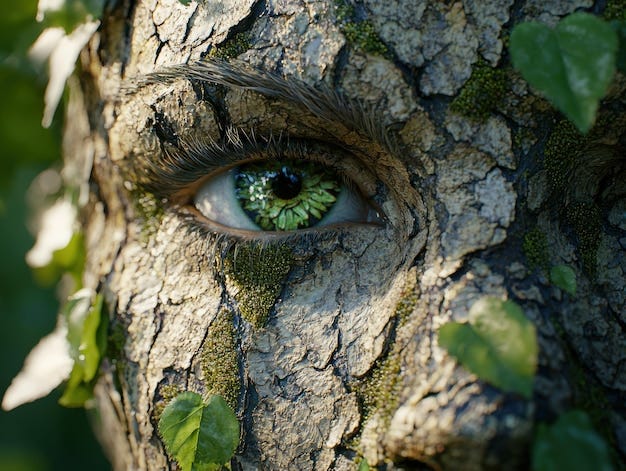Eye Yoga: Healing our Vision for the Future
Gentle Practices for Trauma and Collective Resilience
Happy Beltane! We are at the mid-point between the Spring Equinox and Summer Solstice. And what a time, what a time it has been. Celebrate accordingly my friends— touch grass, hug a tree, smile at a stranger, you know— celebrate the beauty in life <3
Find the audio version by clicking the link below:
In writing this piece on trauma and vision, I know we are all deeply aware that we live in challenging and evocative times. Working on restraint with raw unfiltered hot takes is a practice— I think I used the F-word 30 times in a recent voice note to a friend. Sometimes you just gotta let it rip— a favorite NVC teacher taught me that. After letting the energy move, it’s easier to deconstruct the feelings and needs of an experience. Sometimes, I like that strategy.
What’s happening in the world is heavy. And many of us feel the weight of our global issues—from AI's rapid development to climate change's acceleration. These pressures can create a perfect storm for our nervous systems, especially if we're already carrying our own wounds. My intention is to alleviate the weight, not add more to your load. For me, I’m grateful to be able to get angry, touch grief, even despair and then have my parasympathetic nervous system kick back into gear after just seconds or minutes rather than hours, days, or even weeks.
The practices in this piece are some of the nervous system flexibility practices that helped me to improve the functionality of the “clutch” on my nervous system. I can now shift up and down much more smoothly and I’m deeply grateful for this. I wish the same for you my friend.
This essay emerges from my personal journey through trauma, when my own body showed me the direct link between stress and vision through frightening episodes of double vision, wobbly eyes, and visual distortion. During that time, I couldn't walk, couldn't eat, couldn't sleep. I was so sensitive that the slightest shift in thought could drop me to the ground with a racing heart and collapsed chest heaving for breath. Through this suffering came an embodied understanding that everything is energy—our thoughts directly impact our nervous systems, and how we see shapes what becomes possible for us.
The practices are invitations to reclaim how we perceive our world. In the spirit of both honesty and care, I offer this exploration of trauma's visual dimensions to provide gentle pathways toward healing ourselves and potentially, our collective sight. Despite the extraordinary challenges we face and the increased collective anxiety, I've discovered that even when external circumstances don't improve, our relationship to them can transform. That transformation begins with our thoughts and our bodies, our nervous systems and our eyes—particularly with how we see the world.
With care, Patrick
Before we begin: This essay explores trauma's effects on vision and healing practices. There are practices here that may seem weird or silly because they are unfamiliar. Eye yoga is backed by scientific research and a depth of ancient practices. If you feel activated while reading, pause and take a deep breath. Return when ready.
Our Seeing Bodies
When I faced my deepest struggles, I noticed how stress immediately affected my vision—creating double vision, wobbly focus, and visual distortions. I couldn’t look at a screen long enough to send a text without nearly collapsing. This embodied experience showed me how our nervous systems and visual processing are intimately connected. While we face collective challenges today, our capacity to heal how we see—both literally and metaphorically—offer pathways to personal wellbeing and collective wisdom.
Our eyes aren't just passive receptors taking in light and objects—they actively participate in how we experience the world. By understanding this connection and practicing gentle eye yoga techniques, we can support our nervous systems in finding balance in these uncertain times (Payne et al., 2015).
How Trauma Affects Our Vision
Trauma reshapes how we perceive our world, creating patterns of hypervigilance where our eyes constantly scan for danger rather than rest in safety and beauty. This isn't a personal failure but a physiological protective response (Levine, 2010).
When our nervous systems get stuck in protection mode, our pupils may dilate excessively, making sensory input feel overwhelming. Our visual cortex develops patterns that prioritize threat detection over accurate perception. These changes aren't permanent—they're adaptations that can be gently transformed through practice (Heller & LaPierre, 2012).
The Neurobiology of Projection
Understanding trauma's impact on vision helps explain psychological projection—how we unconsciously attribute our internal feelings to others. When our visual processing is altered by trauma, we may literally see threat in neutral faces or situations, mistaking our internal state for external reality. This visual misinterpretation creates self-reinforcing cycles that affect all relationships (Heller & LaPierre, 2012).
Dr. Robert Naviaux's research on the “cell danger response” referenced in
provides a biological framework for understanding how trauma affects visual processing at the cellular level. When our cells enter protection mode due to perceived threats, they reduce communication with neighboring cells—similar to how trauma can isolate us from others. Visual healing practices help shift our bodies from protection to connection at the cellular level (Naviaux, 2014).
Five Healing Eye Practices
1. Palming: Visual Rest and Reset
Gently warm your hands by rubbing them together, then place your palms over closed eyes, creating a cave of darkness. Allow your eyes to receive complete rest for 2-3 minutes while breathing deeply.
This simple practice gives your visual cortex time to reset from overstimulation and activates your parasympathetic nervous system. Many report immediate calm after just one minute of palming (Payne et al., 2015).
2. Near-Far Focus: Restoring Flexibility
Hold your thumb at arm's length. Focus on it for three breaths, noticing details. Then shift focus to something 20+ feet away for three breaths. Alternate 5-10 times.
This practice helps break “stuck” focusing patterns common after trauma and strengthens your capacity to shift attention consciously rather than reactively (Brom et al., 2017).
3. Slow Eye Rotations: Integration
While keeping your head still, very slowly trace a complete circle with your eyes in one direction, then the other. Move at half the speed that feels natural. Notice the different ways your eyes might jump or get stuck at certain directions.
These gentle rotations activate neural connections between your visual system and vestibular (balance) system, supporting embodied presence (Levine, 2010).
4. Peripheral Awareness Expansion
While looking forward, gradually expand awareness to include what's visible at the edges of your vision without turning to look. Notice shapes and colors in your periphery.
This practice counteracts the tunnel vision of hypervigilance and activates different visual pathways less connected to threat-detection systems (Payne et al., 2015).
5. Synchronized Breathing and Seeing
During any eye practice, consciously coordinate your breath with movement. For example, inhale as eyes move up, exhale as they move down.
This synchronization creates coherence between your visual system and autonomic regulation, building your capacity to stay present during challenging experiences (Porges, 2011).
Integration with Professional Support
For deeper healing, these practices complement professional approaches like EMDR therapy, which uses bilateral eye movements to help process traumatic memories, and somatic approaches, which work with the body's natural capacity to discharge trauma. Both recognize the vision-trauma connection and offer structured protocols for addressing complex trauma under professional guidance (Shapiro, 2014; Payne et al., 2015).
Our visual system evolved primarily for connection and survival in natural environments. Modern visual demands—screens, artificial lighting, and information overload—can strain these ancient systems. By reconnecting with more embodied ways of seeing, we tap into evolutionary wisdom that supports both individual wellbeing and collective resilience (Levine, 2010).
Building Personal Practice
Remember that healing isn't about pushing through discomfort. So often we orient to problems as if they are enemies or threats to be defeated rather than information to explore.
If any exercise feels overwhelming, return to palming or simply focus on your breath. Progress comes through gentle consistency—even 2-3 minutes daily creates meaningful change.
Notice what feels most nourishing—for some it's palming, for others peripheral vision expansion. Let your body's wisdom guide your practice.
Collective Vision and Challenges
While we face real collective challenges, including technological disruption and climate change, our trauma responses can distort how we perceive these challenges. The same biological patterns that create hypervigilance in individual trauma can affect our collective perception, potentially increasing polarization and reactivity. Practices that restore flexible visual processing support our capacity for collective sense-making in complex times (Levine, 2010; Porges, 2011).
As we heal our individual visual systems, we contribute to a collective capacity for clearer perception. Rather than seeing only threat in our changing world, we develop the flexibility to recognize both challenges and opportunities.
This isn't about ignoring what’s tragic about the world, but about ensuring our perception isn't constrained by past trauma. With practice, we can learn to hold both grief and possibility in the same visual field, supporting our collective navigation through uncertainty with wisdom and care.
Our capacity to see clearly—free from the distortions of trauma—may be one of our most essential resources for creating regenerative futures together.
~*~
Best,
Patrick








